I don't really understand what is the perceived "serious problem", zo perhaps you could explain? As has been said, as the 'overall' temp of water in the cylinder increases, the interface s between hotter and cooler strata will gradually move down such that (at least, in domestic-sized vessels {and tis IS a 'DIY forum :-} ). provided that the thermostat is near the bottom, the entre contents of the cylinder will eventually be at much the same temp. won't they?In bigger hot water storage vessels stratification is a serious problem and frequently destratification pumps are fitted which often pump water from the bottom of the vessel into the top (this is in no way the fixed method) in order to breakup the layers. Sometimes
You are using an out of date browser. It may not display this or other websites correctly.
You should upgrade or use an alternative browser.
You should upgrade or use an alternative browser.
Use of immersion heater in summer v central heating for DHW?
- Thread starter ericmark
- Start date
Sponsored Links
Fair enough.Access over to floors to install the wire is simply not there, so wireless is only option.
Is the "9 inches" enough for a shower - or do you perhaps use an electric shower for that.But first question is why do I want DHW? If I want it to take a bath, then clearly top 9" is useless, but I don't, I want enough water to wash hands, and the odd dish when I do not want to wait for dish washer, and 9" is ample for that, so looking at why I want hot water, the question is more about why heat a whole tank of water when only 9" is required, except for the odd time I want a bath?
Yes - but, as we've discussed, that is simply because, if left to its own devices, your oil boiler will heat the entire contents opf the cylinder whereas I presume from what you've said that your immersion (and its thermostat) is positioned, and of such a length, that it only heats about "the top 9 inches".My point is I have without changing anything two methods to heat DHW in the summer, and until this year I have always used the oil boiler option, this year I have moved to electric, and I have realised electric is actually far cheaper than oil, ..... In the past I had just accepted electric costs more than oil, and had never tested it. Seems I was wrong.
That being the case, cannot you simply restrict the time for which the boiler heats the DHW? Despite some of the arguments we're hearing, if you activated the oil-heated DHW system for just, say, 30 mins (or whatever) I feel sure that you could achieve a situation in which the top 9" was hot and the rest much cooler (just as with the immersion) - and if your cylinder is well insulated, you should not have to do that very often (for just the occasional washing of hands and dishes). You could simply switch the oil-fired DHW on for a short time 'manually', but I imagine that your system is 'programmable', such that it could be told to come on for 30 mins (or whatever), say, once or twice per day?
I didn't emphasize the part about bigger vessels, as you say the situation doesn't normally occur in DHW systems.I don't really understand what is the perceived "serious problem", zo perhaps you could explain? As has been said, as the 'overall' temp of water in the cylinder increases, the interface s between hotter and cooler strata will gradually move down such that (at least, in domestic-sized vessels {and tis IS a 'DIY forum :-} ). provided that the thermostat is near the bottom, the entre contents of the cylinder will eventually be at much the same temp. won't they?
What does happen is the hot water rises to the top, just as everyone has been posting, however what happens when the heating stops is the continued currents circulate and the 'hot' water gradually warms the cooler water and the junction between hot and cold gradually lowers, both in location and temperature and it gets deeper to, Of course the 'junction' is not a sudden step it is a zone across which is a graduated temperature.
The overall effect of this is the whole cylinder eventually becomes the junction with a gradual change from hot at the top to cooler at the bottom. In other words the amount of hot water available diminishes. the entire contents is unlikely to be consistant temperature without destratification, quite often a simple 'chute' is attached to the heating coil to encourage a swirling effect.
However in large vessels stratification and some quite sharp temperature changes can occur and it actually makes it difficult to heat a whole vessel. I don't understand why despite several engineers trying to explain it. In one location there were 3 calorifiers of around 1000 gallons each, heated sequencially by running the heating coils in series, however the problem was only about 20-25% of the vessels would heat and several attempts had been made to improve it. All 3 already had destrat pumps between top and bottom and direction had been changed, I assisted with adding a second pump which moved water from just above the heating coil to the bottom of the vessel with a couple of 2" pipes down through an access plate at the top. I assume it worked as we went back to do the other two.
- Joined
- 27 Jan 2008
- Messages
- 25,361
- Reaction score
- 2,981
- Location
- Llanfair Caereinion, Nr Welshpool
- Country

I use instant electric shower, would prefer a shower from DHW, as I would also prefer the washing machines to also use DHW, easier and simpler to store energy as hot water than use batteries, however to alter plumbing would be rather expensive, and getting washing machines that use DHW is getting hard, and again plumbing not installed.Is the "9 inches" enough for a shower - or do you perhaps use an electric shower for that.
The overall effect of this is the whole cylinder eventually becomes the junction with a gradual change from hot at the top to cooler at the bottom. In other words the amount of hot water available diminishes. the entire contents is unlikely to be consistant temperature without destratification, quite often a simple 'chute' is attached to the heating coil to encourage a swirling effect.
As to stratification, and if a problem, it does depend on if you need a hot water tank that big, and often stratification can be a plus, the Willis system seems to be the best option, at least in theory, and it relies on stratification to work, however I live in Mid Wales, and getting a plumber who understands the Willis system is likely to be a problem, in Ulster great, but not so sure in Mid Wales?
With the Willis system the immersion heater timer or multi tank thermostats can be deployed, so without the need for multi immersion heaters you can select how much hot water, my iboost+ is designed for two immersion heaters, but that would involve changing the tank, if we took regular baths then would consider it, but in spite of having two baths, only used one once since moving in.
However the debate is cost, I will freely admit my mothers power shower was the best shower I have used. Which can't be used with combi boilers, but day to day use, in summer (winter is different) the losses using a system boiler to heat the DHW I would think in many cases means electric immersion heaters can be the same or better to using gas or oil to heat the DHW.
If one was installing a new system, all pipes would be lagged, so the answer would change, however even if lagged, using boiler it fired up every other day, so unlikely the pipes would remain warm for next heating time.
This raises another question, using simple time ½ hour slot 4 times a week the pipe work also only heated 4 times a week, however if one was to use a thermostat on the tank, then likely the boiler would fire up more frequent, so losses would increase. For the lagging on the pipes to maintain the pipe temperature between each firing of the boiler seems unlikely.
So two places to loose heat, one in the boiler, and one in the pipe work. The latter will vary house to house, and not everyone lives in a three story house like me, however I remember mothers boiler and sink, a combi boiler with two options standard (small reservoir in boiler ) or eco and boiler worked direct, with the latter, one had to turn hot tap on full, and nearly ½ bowl full of cold water before the hot arrived. So my 20 minutes burn of my oil boiler, likely first 4 minutes taken up heating boiler and pipe work all which is lost.
The flat where the boiler is, under the main house, can have heating turned off independent of main house, and unless we have visitors it is left off, however not seen the flat cooler than 12ºC even in heart of winter, that is because the boiler itself is heating the flat, not a bad thing, don't want pipes to freeze, however it does show how much heat lost from the boiler.
Sponsored Links
As to stratification, and if a problem, it does depend on if you need a hot water tank that big, and often stratification can be a plus, the Willis system seems to be the best option, at least in theory, and it relies on stratification to work, however I live in Mid Wales, and getting a plumber who understands the Willis system is likely to be a problem, in Ulster great, but not so sure in Mid Wales?
So what is the problem? If you understand it, and can direct your plumber - surely, that is all that is needed?
However the debate is cost, I will freely admit my mothers power shower was the best shower I have used. Which can't be used with combi boilers, but day to day use, in summer (winter is different) the losses using a system boiler to heat the DHW I would think in many cases means electric immersion heaters can be the same or better to using gas or oil to heat the DHW.
That is not my experience with gas, heating my cylinder. 120L cylinder, and it costs me around 9Kw to heat up from near cold, at a cost of 37p - derived from my daily Tracker bill.
If unused, that 120L would cool a little, by the next day, despite being insulated. Out of curiosity, some while ago, I decided to see what difference it might make, by adding an old winter bed duvet over the cylinder. It made a surprising difference, the cylinder remained scalding hot, the next day.
- Joined
- 27 Jan 2008
- Messages
- 25,361
- Reaction score
- 2,981
- Location
- Llanfair Caereinion, Nr Welshpool
- Country

Do you really think a Welsh plumber would understand how the Willis system works? Hard enough to find one who knows how central heating works. At least the one doing my central heating admitted he did not know how to wire it, which for me was no problem as I did. But can see why it was in such a mess when I moved in, as finding any one who can do things out of the normal is hard, getting trees cut down, easy, fencing also easy they turn up with tractor and post hole auger and fences all done in very short time, but plumbing and central heating, I noted the sticker on boiler, and clearly was not going to use them. Why would you admit to poor workmanship?So what is the problem? If you understand it, and can direct your plumber - surely, that is all that is needed?
My airing cupboard is stuffed full, hate opening the door, as it all falls out, so would not think much heat escapes.I decided to see what difference it might make, by adding an old winter bed duvet over the cylinder.
I looked at cost of heating 120 litres, around 8.5 kWh so it would cost at 31.31p per kWh around £2.70, however today 11:20 am the iboost+ says water tank hot, so thermostat has switched off, and I have used 0.25 kWh at no cost to me anyway, as not paid for export, but even if it was costing, it would have cost 7.83p at most. Now to use oil the boiler runs for 20 minutes 4 times a week, at 20 kW so 3.8 kWh per day, as a 20 kW boiler, so to break even the oil needs to be 15 times cheaper, as said the distance boiler to storage tank will make a difference, but the big problem is although these
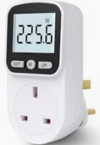 are easy to use, immersion heaters tend not to have a plug and socket, so the shower, immersion heater, and cooker, are the three items in our homes which we can't easy monitor power use, and it was not until the iboost+ was fitted that I had any way to measure the power used by the immersion heater.
are easy to use, immersion heaters tend not to have a plug and socket, so the shower, immersion heater, and cooker, are the three items in our homes which we can't easy monitor power use, and it was not until the iboost+ was fitted that I had any way to measure the power used by the immersion heater.Same with oven, an air frier is basic a small fan oven, likely cheaper to use than a large oven, a microwave tends to be using power all the time it is on, where air frier and ovens switch on/off once hot with a mark/space ratio, to compare needs to cook same food, never tried to do a baked potato in air frier, normally start in micro wave the transfer to oven with the pizza, air frier not big enough to do a pizza in, so considering will be using oven for pizza, is it really worth (other than speed) starting the baked potatoes in the microwave? Measuring watt, or amps is easy, measuring on time is not with items not using a 13 amp plug.
So we read what others have said, again if my boiler was gas, it would likely modulate, so for the boiler to run for an hour, tells us nothing, as it may be anywhere between 6 and 28 kW, but my oil boiler is simply on/off, so if it runs for 20 minutes and its a 18 kW boiler, then easy 6 kW has been used. Actually 20 kW and normally slightly over 20 minutes run time, and the water is a bit on the cool side, but we have some idea at least of energy used.
Smart meters are about as good as a chocolate fire guard, as they measure whole house, so freezers etc are cutting in and out, and only work when no sun, as the export figure tells us nothing as to what the home is using, and the solar software has a delay, I can view this
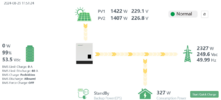 and see the sun disappear behind a cloud, but change is some 15 minutes latter, big problem some info relied by server in china, and some direct, so view totals for day and reasonably accurate, but I can make a cup of coffee, and come upstairs, and the spike due to making coffee has still not shown.
and see the sun disappear behind a cloud, but change is some 15 minutes latter, big problem some info relied by server in china, and some direct, so view totals for day and reasonably accurate, but I can make a cup of coffee, and come upstairs, and the spike due to making coffee has still not shown.So not seen any replies from some one who can measure the energy used in the way I can as yet, calculations are no good, need some way to actually measure the energy.
as said the distance boiler to storage tank will make a difference, but the big problem is although theseare easy to use, immersion heaters tend not to have a plug and socket, so the shower, immersion heater, and cooker, are the three items in our homes which we can't easy monitor power use, and it was not until the iboost+ was fitted that I had any way to measure the power used by the immersion heater.
That's where a smart meter comes in, if you can turn everything else, to off, whilst that one appliance is used. That is how I was able to check my gas consumption - no heating used that day, no cooking done, just the cylinder reheated from cold.
The willis system relies on a significant thermally induced water flow through the heating device which (as I understand it) is the exact opposite of stratification where the thermal layers stay firmly in place, rock formation layers are also stratification as are the atmospheric layers around our home.As to stratification, and if a problem, it does depend on if you need a hot water tank that big, and often stratification can be a plus, the Willis system seems to be the best option, at least in theory, and it relies on stratification to work,
- Joined
- 13 Mar 2019
- Messages
- 975
- Reaction score
- 261
- Country

Shelly do multi-channel energy monitors.need some way to actually measure the energy.
If you're really serious, OpenEnergyMonitor eMonTX variants can take up to 12 CTs.
- Joined
- 27 Jan 2008
- Messages
- 25,361
- Reaction score
- 2,981
- Location
- Llanfair Caereinion, Nr Welshpool
- Country

Back ground use is a problem, at moment using my laptop and  likely one of the freezers is running, and at 379 watt when export is
likely one of the freezers is running, and at 379 watt when export is 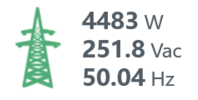 why should I worry? Getting oil is a pain, I have to take a torch to see how much we have, and phone up for new supply, the pay for it of course, where electric the standing order is paid each month and I can forget about it.
why should I worry? Getting oil is a pain, I have to take a torch to see how much we have, and phone up for new supply, the pay for it of course, where electric the standing order is paid each month and I can forget about it.
If using solar for DHW changes it from twice a year top up to once a year, that is a bonus. The energy meter be it plug in or smart is something of passing interest, and checking the freezers will show when one is failing. I can see the auto defrost ran today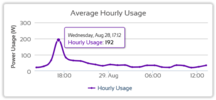 and the motor is switching off,
and the motor is switching off, 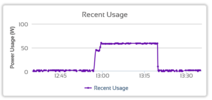 so all is well, but once the novelty has warn off, they do very little, we get into a routine and we tend to stick to it, rain or shine, but some times we realise things are not as expected, we know for example there is a 1 watt standby rule, and when I found my old sky box used around 11 watt on standby I was surprised, it seems it kept the LNB powered so it could detect program changes.
so all is well, but once the novelty has warn off, they do very little, we get into a routine and we tend to stick to it, rain or shine, but some times we realise things are not as expected, we know for example there is a 1 watt standby rule, and when I found my old sky box used around 11 watt on standby I was surprised, it seems it kept the LNB powered so it could detect program changes.
I am sure if I got a weather forecast I could change the time when I stop charging battery so that maximum solar is stored, but I don't, yesterday I spend a whole 99p on electric, £1.58 if I include the standing charge, is it really worth weather watching for that amount of money?
But I can see I made an error when selecting to use oil to heat water, I had seen so many times people say oil and gas is cheaper than using electric, I just accepted what I had been told, and clearly I have been told wrong, far cheaper in summer to use electric. Some lies told are obvious, we all know you can't turn lights on/off by clapping hands once a smart meter is fitted, but the oil/gas v electric thing had taken me in hook line and sinker, I was convinced oil was cheaper even when in real terms more like 3 times more expensive to using electric.
 likely one of the freezers is running, and at 379 watt when export is
likely one of the freezers is running, and at 379 watt when export is  why should I worry? Getting oil is a pain, I have to take a torch to see how much we have, and phone up for new supply, the pay for it of course, where electric the standing order is paid each month and I can forget about it.
why should I worry? Getting oil is a pain, I have to take a torch to see how much we have, and phone up for new supply, the pay for it of course, where electric the standing order is paid each month and I can forget about it.If using solar for DHW changes it from twice a year top up to once a year, that is a bonus. The energy meter be it plug in or smart is something of passing interest, and checking the freezers will show when one is failing. I can see the auto defrost ran today
 and the motor is switching off,
and the motor is switching off,  so all is well, but once the novelty has warn off, they do very little, we get into a routine and we tend to stick to it, rain or shine, but some times we realise things are not as expected, we know for example there is a 1 watt standby rule, and when I found my old sky box used around 11 watt on standby I was surprised, it seems it kept the LNB powered so it could detect program changes.
so all is well, but once the novelty has warn off, they do very little, we get into a routine and we tend to stick to it, rain or shine, but some times we realise things are not as expected, we know for example there is a 1 watt standby rule, and when I found my old sky box used around 11 watt on standby I was surprised, it seems it kept the LNB powered so it could detect program changes.I am sure if I got a weather forecast I could change the time when I stop charging battery so that maximum solar is stored, but I don't, yesterday I spend a whole 99p on electric, £1.58 if I include the standing charge, is it really worth weather watching for that amount of money?
But I can see I made an error when selecting to use oil to heat water, I had seen so many times people say oil and gas is cheaper than using electric, I just accepted what I had been told, and clearly I have been told wrong, far cheaper in summer to use electric. Some lies told are obvious, we all know you can't turn lights on/off by clapping hands once a smart meter is fitted, but the oil/gas v electric thing had taken me in hook line and sinker, I was convinced oil was cheaper even when in real terms more like 3 times more expensive to using electric.
Some lies told are obvious, we all know you can't turn lights on/off by clapping hands once a smart meter is fitted, but the oil/gas v electric thing had taken me in hook line and sinker, I was convinced oil was cheaper even when in real terms more like 3 times more expensive to using electric.
Eric, it is obviously intended as an amusing ad.. I'm sure no one believes goats go hang gliding, or that elephant seals steal power boats, as in the Virgin ads.. Obviously though, the easier a light is to turn off, the more likely that it will be turned off when necessary, so the more energy can be saved/the lower your bills. For example, I can ask Alexa to turn off the TV's, when we walk out the house, or I disappear into my workshop for a while. So easy, I do it, whereas before, I might have just not bothered and left it on.
Electric, for us here, varies between just over double, and three times the cost of gas. However, gas is some 10 to 20% less efficient than would be electric heating our water, wear and tear on the heating system cost , is not something I have considered, nonetheless, it does retain its edge as the cheaper fuel for hot water, except for our electric shower use.
- Joined
- 27 Jan 2008
- Messages
- 25,361
- Reaction score
- 2,981
- Location
- Llanfair Caereinion, Nr Welshpool
- Country

As said when clearly ridiculous one sees it as a bit of fun, not sure I can turn off TV with voice, but can with many items.
For my oil boiler to start heating the DHW it clearly needs to get boiler hot to start with, then all the pipes need to heat up, so unsure how much of the 20 minute burn is used to actually heat the water, the same is clearly true with the CH, but the burn is more like 4 hours, not 20 minutes, I am sure cheaper to use oil than electric to get enough hot water for a bath, but hand washing no, likely electric is the cheaper.
That I understood, but what I had not considered was the price of the match, i.e. what it costs to turn on the boiler, even if not used. I should have done, it's a big thing with heritage railways, getting an engine in steam is costly, even if not used, so often the diesel is used as standby.gas is some 10 to 20% less efficient
For my oil boiler to start heating the DHW it clearly needs to get boiler hot to start with, then all the pipes need to heat up, so unsure how much of the 20 minute burn is used to actually heat the water, the same is clearly true with the CH, but the burn is more like 4 hours, not 20 minutes, I am sure cheaper to use oil than electric to get enough hot water for a bath, but hand washing no, likely electric is the cheaper.
Doesn't necessarily work that way.That being the case, cannot you simply restrict the time for which the boiler heats the DHW?
Let's say we want the top of the tank at 60°C, and the boiler is set up for a max delta-T of 20°C (stanard max for gas boilers). Absent "something additional", to get 60° out of the boiler means putting 40° in - so you have to partially heat the entire tank.
That "something" can be one of several things :
When I put a thermal store in the flat I used a srandard TMV (as used under sinks to limit water temp. from the hot tap) to set a minimum temperature of the water into the boiler - though that was to prevent condensing with a non-condensing boiler. Below that, it circulates water round the boiler loop rather than through the store so it can heat up quickly.
At home, I used a diverter valve from ESBE which achieves the same function, but instead sensing boiler outflow temp. It means it can't circulate water through the store when there's pump overrun.
Similarly, it's common to fit a loading valve on a wood stove. That's to ensure a high enough water temperature to avoid running the stove too cool which can make the stove and flue get coated in "tar".
All of those can allow for only heating part of the tank to a usable temperature - assuming direct as my stores are. It's a bit more complicated if indirect as (as mentioned earlier) you then get complex currents in the tank as hot water round the coil thermosyphons upwards through cooker water.
Yes, I realised/suspected that - which is why I reminded you that this is a DIY forumI didn't emphasize the part about bigger vessels, as you say the situation doesn't normally occur in DHW systems.
That's not really 'stratification' but, rather, the opposite ( 'de-stratification'). Stratification exists initially, when the heated water has risen to the top (the top 'stratum') with cooler water below it (lower 'strata') and what you are describing is the gradual warmer of water lower down, therefore progressively reducing the stratification.What does happen is the hot water rises to the top, just as everyone has been posting, however what happens when the heating stops is the continued currents circulate and the 'hot' water gradually warms the cooler water and the junction between hot and cold gradually lowers, both in location and temperature and it gets deeper to,
I have never deliberately done that experiment with my system. As I've said, on switching on a 'bottom heater' from cold, hot water rapidly appears at the top of the cylinder (and can be drawn off) pretty quickly, but I don't know to what extent, and for how long, the water at the top remains hot (rather than 'mixing' with the rest of the water in the cylinder) after the heater is turned off.
It presumably is essentially impossible, even in a DHW cylinder, to have water at identical temp throughout the vessel, since there will inevitably be some temp gradient between top and bottom.However in large vessels stratification and some quite sharp temperature changes can occur and it actually makes it difficult to heat a whole vessel.
The 'large-vessel problem' you refers to presumably relates to the fact that, given the inevitability (without 'intervention') of a temp gradient means that the temp at the top might be 'too hot' by the time that at the bottom was 'inadequately high'. In a kitchen or chemistry lab, one would probably address comparable issues simply by 'stirring' the water, what you mentioned (pumping water from bottom to top) would be a somewhat more complicated way of achieving the same 'mixing'.
DIYnot Local
Staff member
If you need to find a tradesperson to get your job done, please try our local search below, or if you are doing it yourself you can find suppliers local to you.
Select the supplier or trade you require, enter your location to begin your search.
Please select a service and enter a location to continue...
Are you a trade or supplier? You can create your listing free at DIYnot Local
Sponsored Links
Similar threads
- Replies
- 0
- Views
- 296
- Replies
- 36
- Views
- 3K
